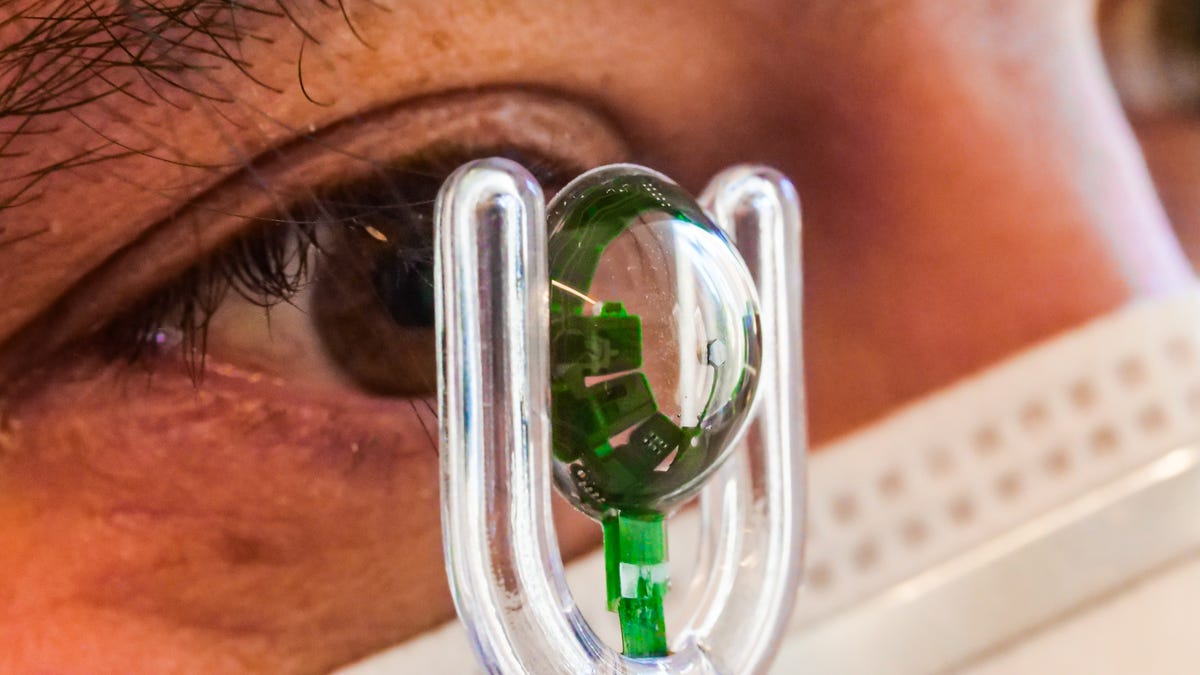Mojo's Smart Contact Lenses Begin In-Eye Testing
CEO Drew Perkins discusses what the first demo was like. By year's end, I could be next.

CNET testing Mojo Vision's lens off-eye in a demo earlier this year.
I've brought a tiny, chip-studded, display-enabled contact lens made up to my eye, but I never was actually able to wear it. But by the end of 2022, I might get a chance. Mojo Vision's smart contact lenses, which have been in development for years, are finally being worn internally, starting with the company's CEO Drew Perkins.
Perkins, who I spoke to over Zoom, has only worn the lens for an hour at a time so far. He likens the first tests to a baby learning to walk: "We've now taken that first step. And it's very exciting."
Perkins tested a few of the Mojo Lens app demos I tried with the lens on a stick earlier this year, reading text off a teleprompter app that put tiny text floating in a display in front of his eye, and looking at an image of Albert Einstein in green monochrome, which Perkins said "looked great." He also demoed the lens' compass app that I tried, which used a built-in magnetometer to show compass readouts in real time. "I was able to spin around 360 degrees and see it [go] from north, to northeast, to east, to southeast," he said. "It was very cool."
Mojo Vision's hardware for the lens requires a neck-worn processor that wirelessly relays information to the lens and back to computers that track the eye movement data for research. For the moment, the setup also requires a special cap with an antenna built in that Perkins is wearing to ensure a smooth connection for early testing.
The lenses have a tiny MicroLED display onboard, a short-range custom wireless radio, a tiny ARM processor and motion tracking in the form of an accelerometer, gyroscope and magnetometer. It's the same lens hardware I looked at off-eye back in the spring of this year. The lenses enable eye-controlled head-up displays to appear to hover in-air, approaching a type of monochromatic Google Glass-like AR interface without glasses.
The company's only doing tests with one lens in one eye for the moment, although the next goal is to have two lenses worn at once for 3D visual overlays. After Perkins, who's still just wearing the lens intermittently for about an hour at a time for testing, other executives at the company will be trying the hardware. Perkins says these early stages are just trying to get the hardware on its feet: "We spent lots of time just validating and calibrating the radio, to make sure the radio is working," he says. "We're not doing extended-time testing yet. We'll get there."
"With this advancement, we now have a testing platform that helps us refine and build Mojo Lens that will ultimately lead to submission to the FDA for market approval," Perkins adds in a statement about the milestone. "To accomplish this, we will conduct several clinical studies to test capabilities and provide feedback on software and apps."
By the end of this year, Mojo Vision's goal is to test the lens out beyond company executives, to partners such as those interested in exploring fitness and health training possibilities, or investors or journalists. I admit I feel pretty nervous about the idea of putting a lens filled with processors into my eye: the deepest I've ever worn tech is earbuds in my ears.
But based on how Perkins describes the state of smart contact lenses, they're still extremely early in a prototype phase that's only now just getting to a first-step wearable form. Where they go next will certainly take time, and it's unclear how quickly that process will move. I know I've been amazed by just looking through a lens held a few millimeters from my eye, but actually wearing one is a whole other leap forward.

